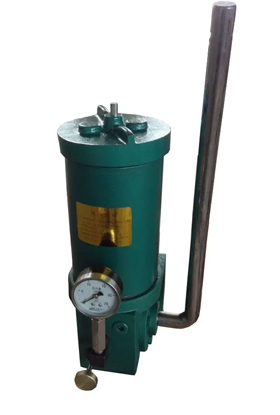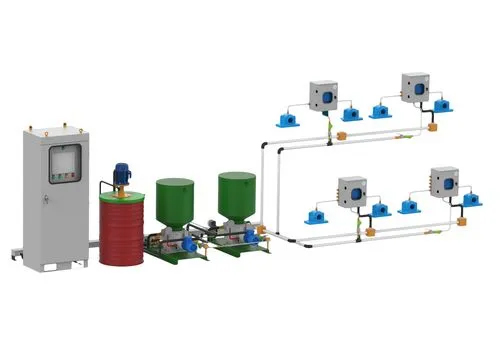What are the Types of Lubrication Pumps?
Lubrication pumps are essential tools for ensuring the smooth and efficient operation of machinery across various industries. They come in different types, each designed to meet specific application needs. In this blog post, we will provide a comprehensive guide to the various lubrication pump types, explaining their characteristics and typical applications.
Manual Lubrication Pumps
Manual lubrication pumps are basic and user-operated. They are typically hand-pumped or lever-operated to deliver lubricant to the machinery. These pumps are suitable for smaller-scale applications and equipment that require occasional lubrication. Common examples include grease guns and oil cans.
- Working principle: Manual lubrication pumps are operated by hand, and their working principle is straightforward. When the user activates the pump (usually by squeezing a lever or pumping a handle), it generates pressure inside the pump. This pressure forces the lubricant, whether grease or oil, to flow through a nozzle or dispenser, allowing the user to apply it directly to the lubrication points on the machinery.
- Applications: Handheld manual pumps are commonly used in automotive maintenance, small machinery, and equipment with infrequent lubrication needs.
Grease Pumps
Grease pumps are designed to dispense grease to lubricate machine components. They are available in manual and powered variations. Powered grease pumps, often driven by pneumatic or electric sources, provide a continuous supply of grease for efficient lubrication. Such as ATO-OW-008, pneumatic grease pump.
- Working principle: Grease pumps, whether manual or powered, work by creating pressure within a reservoir containing grease. In manual pumps, the user's effort generates the pressure, while in powered pumps, an electric, pneumatic, or hydraulic system does the work. The pressure forces the grease through a hose or pipe to the application point, where it is dispensed to lubricate the machine components.
- Applications: Grease pumps are frequently employed in automotive garages, industrial machinery, and manufacturing plants where grease is the preferred lubricant.
Oil Pumps
Oil pumps, as the name suggests, are designed for the delivery of oil-based lubricants. They are commonly used in applications where oil provides the best lubrication. Like grease pumps, oil pumps can be manual or powered, with electric, pneumatic, or hydraulic drive mechanisms.
- Working principle: Oil pumps function similarly to grease pumps. They maintain a reservoir of oil and create pressure, which can be generated manually or through a power source. The pressurized oil is then delivered through a hose or tubing to the machinery's lubrication points, ensuring proper lubrication.
- Applications: Oil pumps are found in various industries, including automotive, metalworking, and manufacturing, where oil lubrication is necessary for specific equipment.
Centralized Lubrication Systems
Centralized lubrication systems are automated systems that distribute lubricants to multiple points within a machine or system. They are often controlled by timers, controllers, or sensors. Centralized systems come in various configurations, including single-line, dual-line, and progressive systems.
- Working principle: Centralized lubrication systems employ a network of pipes, valves, and distributors to deliver lubricants to multiple points within a machine or system. The central pump generates the pressure, and the lubricant is distributed through a series of pipes to various lubrication points. These systems often use timed or controlled release mechanisms to ensure proper lubrication at each point.
- Applications: Centralized lubrication systems are ideal for large industrial machinery, conveyor systems, and complex equipment with multiple lubrication points.

Automatic Lubrication Systems
Automatic lubrication systems take centralized systems a step further by continuously and precisely delivering lubricants. They are equipped with controllers and can be set to dispense lubricant at specific intervals or based on machine operation.
- Working principle: Automatic lubrication systems are sophisticated and rely on controllers and sensors to deliver lubricants. They continuously monitor the equipment's operation and dispense lubricant at precise intervals or when certain conditions are met. These systems can use various mechanisms, including pumps, injectors, and valves, to ensure consistent and automatic lubrication.
- Applications: Automatic lubrication systems are commonly used in heavy machinery, construction equipment, and industrial automation where consistent and precise lubrication is critical.
Recirculating Lubrication Systems
Recirculating lubrication systems recirculate lubricants through a closed-loop system. They are designed to maintain a constant supply of clean lubricant, making them suitable for applications where contamination prevention is crucial.
- Working principle: Recirculating lubrication systems maintain a closed loop of lubricant, typically involving a reservoir, pump, and a series of pipes or tubing. The pump continuously recirculates the lubricant through the system, filtering and cooling it as necessary. This method ensures a constant supply of clean lubricant to lubrication points while minimizing waste and contamination.
- Applications: Recirculating systems are used in demanding environments, such as steel mills, paper mills, and other heavy industrial applications.
Positive Displacement Lubrication Pumps
Positive displacement pumps are designed to deliver a fixed volume of lubricant with each cycle of operation. They are known for their precision and are often used in applications where accurate lubricant delivery is required.
- Working principle: Positive displacement pumps work by trapping a fixed volume of lubricant and then forcing it out with each cycle. These pumps are known for their precision. Common types of positive displacement pumps include gear pumps, piston pumps, and diaphragm pumps. As the pump mechanism moves, it draws in lubricant and then pushes it out in a controlled and precise manner to the lubrication points.
- Applications: Positive displacement pumps find applications in precision machinery, high-speed manufacturing, and equipment requiring consistent lubrication.
The selection of the right lubrication pump type depends on the specific needs of the machinery and the application. Understanding the characteristics and advantages of each type of lubrication pump is essential for making informed decisions about which pump to use in different industrial settings. Whether it's manual, powered, centralized, or automatic, the proper lubrication pump can significantly contribute to the efficiency and longevity of equipment.

